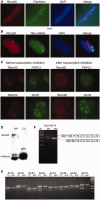Rbm20 regulates titin alternative splicing as a splicing repressor
- PMID: 23307558
- PMCID: PMC3575840
- DOI: 10.1093/nar/gks1362
Rbm20 regulates titin alternative splicing as a splicing repressor
Abstract
Titin, a sarcomeric protein expressed primarily in striated muscles, is responsible for maintaining the structure and biomechanical properties of muscle cells. Cardiac titin undergoes developmental size reduction from 3.7 megadaltons in neonates to primarily 2.97 megadaltons in the adult. This size reduction results from gradually increased exon skipping between exons 50 and 219 of titin mRNA. Our previous study reported that Rbm20 is the splicing factor responsible for this process. In this work, we investigated its molecular mechanism. We demonstrate that Rbm20 mediates exon skipping by binding to titin pre-mRNA to repress the splicing of some regions; the exons/introns in these Rbm20-repressed regions are ultimately skipped. Rbm20 was also found to mediate intron retention and exon shuffling. The two Rbm20 speckles found in nuclei from muscle tissues were identified as aggregates of Rbm20 protein on the partially processed titin pre-mRNAs. Cooperative repression and alternative 3' splice site selection were found to be used by Rbm20 to skip different subsets of titin exons, and the splicing pathway selected depended on the ratio of Rbm20 to other splicing factors that vary with tissue type and developmental age.
Figures







Similar articles
-
Molecular basis of titin exon exclusion by RBM20 and the novel titin splice regulator PTB4.Nucleic Acids Res. 2018 Jun 1;46(10):5227-5238. doi: 10.1093/nar/gky165. Nucleic Acids Res. 2018. PMID: 29518215 Free PMC article.
-
Insulin regulates titin pre-mRNA splicing through the PI3K-Akt-mTOR kinase axis in a RBM20-dependent manner.Biochim Biophys Acta Mol Basis Dis. 2017 Sep;1863(9):2363-2371. doi: 10.1016/j.bbadis.2017.06.023. Epub 2017 Jul 1. Biochim Biophys Acta Mol Basis Dis. 2017. PMID: 28676430 Free PMC article.
-
A mutation in the glutamate-rich region of RNA-binding motif protein 20 causes dilated cardiomyopathy through missplicing of titin and impaired Frank-Starling mechanism.Cardiovasc Res. 2016 Oct;112(1):452-63. doi: 10.1093/cvr/cvw192. Epub 2016 Aug 5. Cardiovasc Res. 2016. PMID: 27496873
-
The Emerging Role of the RBM20 and PTBP1 Ribonucleoproteins in Heart Development and Cardiovascular Diseases.Genes (Basel). 2020 Apr 8;11(4):402. doi: 10.3390/genes11040402. Genes (Basel). 2020. PMID: 32276354 Free PMC article. Review.
-
Titin diversity--alternative splicing gone wild.J Biomed Biotechnol. 2010;2010:753675. doi: 10.1155/2010/753675. Epub 2010 Mar 21. J Biomed Biotechnol. 2010. PMID: 20339475 Free PMC article. Review.
Cited by
-
Rbm24a and Rbm24b are required for normal somitogenesis.PLoS One. 2014 Aug 29;9(8):e105460. doi: 10.1371/journal.pone.0105460. eCollection 2014. PLoS One. 2014. PMID: 25170925 Free PMC article.
-
Alternative Splicing in Tumorigenesis and Cancer Therapy.Biomolecules. 2025 May 29;15(6):789. doi: 10.3390/biom15060789. Biomolecules. 2025. PMID: 40563429 Free PMC article. Review.
-
Clinical Insights in RNA-Binding Protein Motif 20 Cardiomyopathy: A Systematic Review.Biomolecules. 2024 Jun 14;14(6):702. doi: 10.3390/biom14060702. Biomolecules. 2024. PMID: 38927106 Free PMC article.
-
I536T variant of RBM20 affects splicing of cardiac structural proteins that are causative for developing dilated cardiomyopathy.J Mol Med (Berl). 2022 Dec;100(12):1741-1754. doi: 10.1007/s00109-022-02262-8. Epub 2022 Oct 5. J Mol Med (Berl). 2022. PMID: 36198914 Free PMC article.
-
Dynamics of genome reorganization during human cardiogenesis reveal an RBM20-dependent splicing factory.Nat Commun. 2019 Apr 4;10(1):1538. doi: 10.1038/s41467-019-09483-5. Nat Commun. 2019. PMID: 30948719 Free PMC article.
References
-
- Bang ML, Centner T, Fornoff F, Geach AJ, Gotthardt M, McNabb M, Witt CC, Labeit D, Gregorio CC, Granzier H, et al. The complete gene sequence of titin, expression of an unusual approximately 700-kDa titin isoform, and its interaction with obscurin identify a novel Z-line to I-band linking system. Circ. Res. 2001;89:1065–1072. - PubMed
-
- Labeit S, Kolmerer B. Titins: giant proteins in charge of muscle ultrastructure and elasticity. Science. 1995;270:293–296. - PubMed
-
- Maruyama K, Kimura S, Yoshidomi H, Sawada H, Kikuchi M. Molecular size and shape of beta-connection, an elastic protein of striated muscle. J. Biochem. 1984;95:1423–1433. - PubMed
-
- Trinick J, Knight P, Whiting A. Purification and properties of native titin. J. Mol. Biol. 1984;180:331–356. - PubMed
Publication types
MeSH terms
Substances
Grants and funding
LinkOut - more resources
Full Text Sources
Other Literature Sources
Molecular Biology Databases
Miscellaneous

